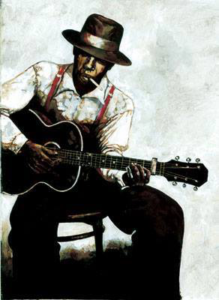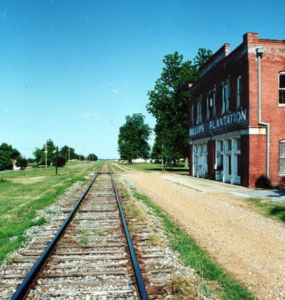The Roots of Toni Morrison’s Durative Blues

Thought Catalog from Pexels
Novels and stories worldwide share prototypical story structures or plots; for instance, Patrick Hogan identifies 3 “universal narrative prototypes”: Sacrifice, Heroism, and Romantic Love, each of which has many variants. Yet in order to comprehend prototypes in African American literature in general, and in Toni Morrison’s work in particular, we have to turn to the Black Aesthetic.
This amalgamation of artistic practices from the descendants of slaves brought to North America and the Caribbean circa 1600 is covered more extensively in the blog piece, The Black Arts Movement and Beyond; in this blog, we will consider the foundational artistic practice known simply, but elegantly, as “the blues.” We can discover how the Beloved, Jazz, and Paradise project can be opened up to rich conversation and reflection through what I’m calling the Durative Blues prototype.
“you know, that music that laughs and cries at the same time”
–Langston Hughes
Defining the Blues? Some people say it can’t be done in words. That very well may be, but the spoken words of the blues, along with written reflections and analyses of it, are rich knowledge-banks for experiencing the African American musical tradition known as the Blues. I have carefully chosen several statements from musicians and critics to lay out for us those aspects of a Blues aesthetic that impinge on Toni Morrison’s work:
The blues as such are synonymous with low spirits. Blues music [italics added] is not. . . . . . Not only is its express purpose to make people feel good, which is to say in high spirits, but in the process of doing so it is actually expected to generate a disposition that is both elegantly playful and heroic in its nonchalance. —Albert Murray, Stomping the Blues
In Blue Devils,1 another book by music critic Albert Murray, we read that a in blues performance, as lyrics play out over the somewhat sombre “blue” notes, a kind of double-discourse emerges, evoking irony along with sadness, or defiance with humiliation, etc., for the purpose of “riffing on the exigencies of the predicament”; an improvisational affirmation. Furthermore, as most African American musical theorists and critics argue, it is in the experiencing of the blues—a duration—that is key.
Houston Baker helps us out with a literary approach to this when he cites the quality of the blues as “durative”: even as [blues musicians] speak of paralyzing absence and ineradicable desire, their instrumental rhythms suggest change, movement, action, continuance, unlimited and unending possibility . . . blues are always nomadically wandering” (Blues, Ideology, and Afro-American Culture 8). While the blues lyrics might be about injustice, despair, or loss, there is an “instrumental energy” that can achieve a “resonant, improvisational, expressive dignity” (13). In other words, enduring, and rather playfully, defiantly, beautifully.

Bessie Smith Portrait by Carl Van Vechten 1936
Listening Interlude: “Backwater Blues
Experiencing the music is a rich resource for understanding the blues aesthetic, as it has developed into an intermedial tradition, affecting literature, painting, and other art forms. In the concrete, literal sense, blues music features a series of 3-line stanzas, where each line consists of 4 measures. The first 2.5 measures in a line is for the singer, the last 1.5 for the instrument(s); a call-and-response pattern.1 Listen for it in the Bessie Smith tune Hear it in the Bessie Smith tune, “Backwater Blues,” recorded in 1927:
https://www.youtube.com/watch?v=wgBWGR0E83Y&list=RDwgBWGR0E83Y&start_radio=1
Notice what it feels like when the second line in the stanza shifts chords (to the IV scale, then back to the I) but the words remain the same as in the first line. This is a repetition-with-difference. Notice also the tones of the A, D, E progression, frequently termed “blue notes.”
Could “Backwater Blues” offer such, to the singers and listeners? Consider its historical context: it alludes to the Great Mississippi Flood of 1927 when 27,000 square miles of land was submerged dislocating thousands of people, many of them African Americans, along the southern Mississippi river region. Additionally, haven’t you known some morning when getting yourself out of bed seemed impossible–“can’t even get outta my door”–but you did it anyway–“enough trouble to make a poor girl wonder why she wanna go”?
1 it also follows the classical pattern of the 12-bar blues: four 3-line stanzas with a I, IV, V scales progression played out across each stanza, each line ending in the I chord (tonic).

Portrait Robert Johnson
To endure hardships that may not have any resolution or end, one or more people can perform the blues. This can provide, in the words of an African American poet, “an atmosphere in which analysis can take place”:
Unlike sacred music, the blues deals with a world where the inability to solve a problem does not necessarily mean that one can, or ought to, transcend it. . . . The blues singer strives to create an atmosphere in which analysis can take place.” —Sherley Ann Williams, “The Blues Roots of African American Poetry”
Toni Morrison’s Beloved, Jazz, and Paradise trilogy are just such performances, with an emphasis on the durative, what in one decade not so long ago was phrased as “keep on keepin’ on.” And doing so with style and grace.
Morrison has honed to perfection a significant literary prototype to be found throughout African American literature: a story-arc sequence of events, memories, and narrative tonalities that enact, say, a blues singer at the railway junction.

Railroad Station
One last point about the blues will deepen this significance of its experiential quality. According to Amiri Baraka and Houston Baker, whose works on the blues in literature (Blues People and Blues, Ideology, and Afro-American Literature: A Vernacular Theory respectively) are ranked as classics, blues pieces always have location, a specific place, and there is movement from, to, and across this space. This is helpful in imagining a range of the spatial/temporal dimensions of a blues work: “the black blues singer at the railway junction” whose “inhabitants are always travelers.”
Whether or not this is apparent within every song from the canon of African American blues music, it is a driving force behind African American art forms in general; it is one of the characteristics that Olly Wilson, in his seminal piece, “The Heterogeneous Sound Ideal in African-American Music,” is referring to when he asserts that African American art forms have “a shared conceptual framework,” with the emphasis on “a way [emphasis added] of doing something, not just something that is done.”
Responses Invitation: reflect, write, post:
Before you go to the next blog in this sequence—“Life is that large”: Blues-Durative Sequences in the Trilogy, containing illustrations from each novel with concrete examples and details–why not try your hand, so to speak, at a response by considering how one of the following might fit into a bluesy-narrative context:
—In Beloved, Paul D’s walking north, “following the blossoms” to Delaware.
—In Jazz, Violet’s memories of her mother, aunt Truebelle’s stories, and the well.
—In Paradise, Pallas Truelove’s reaction to the woman at the mall and her subsequent experiences with Carlos and her mother.
–in any novel you’ve read besides these; your choice!
Continue this thread with the next Emotions blog, “Life is that large”: Blues-Durative Sequences in the Trilogy.
And please sign up for the Newsletter at the bottom of any page!
1 Blue Devils is also the name of a blues band out of Oklahoma City in the 1930’s.
